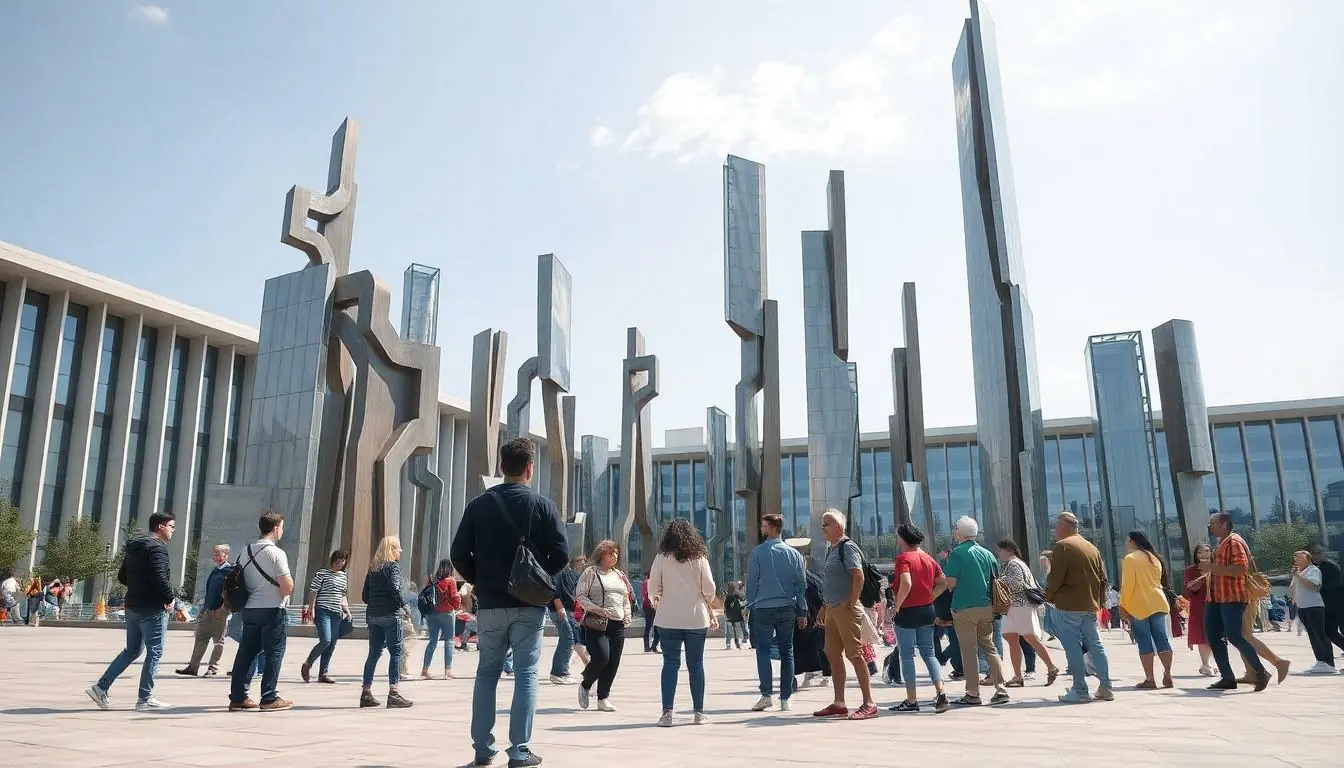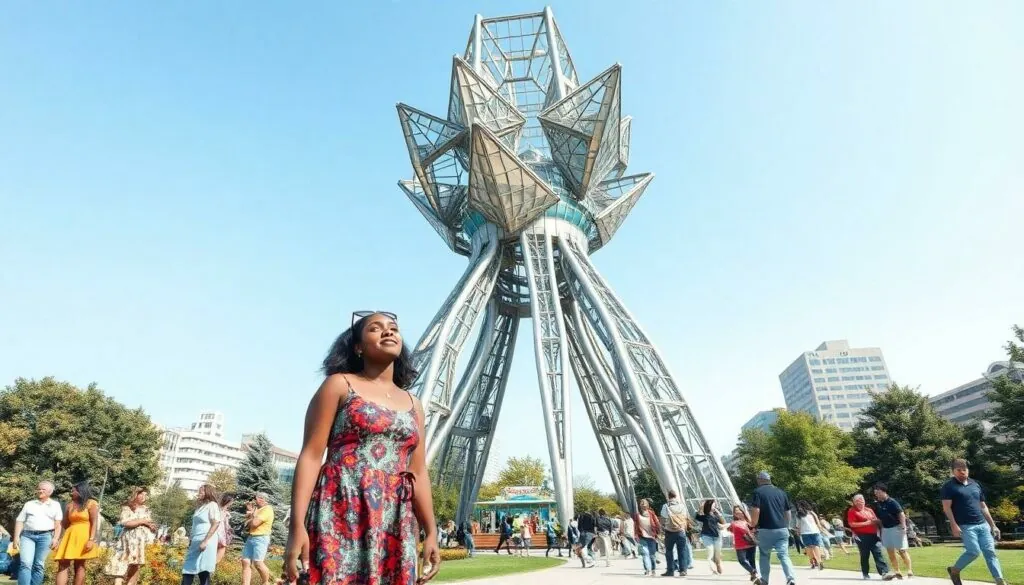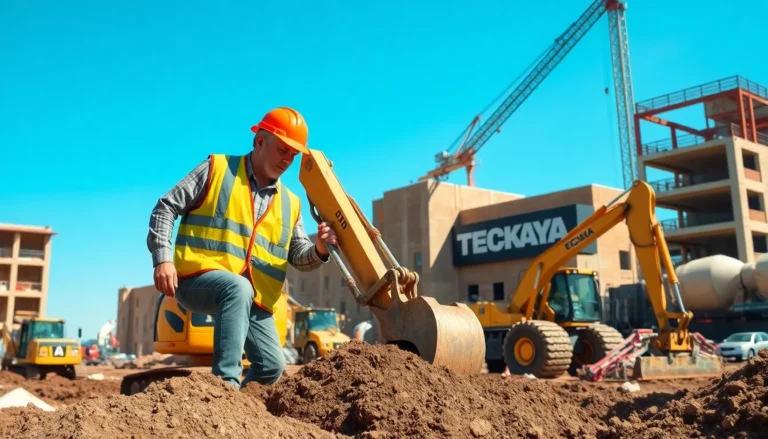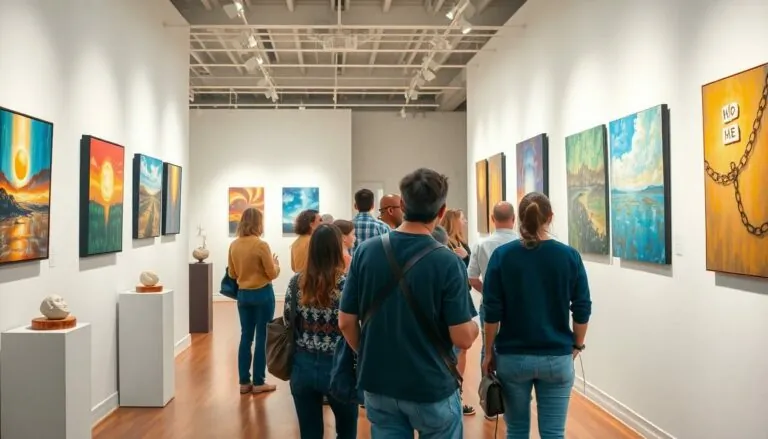Table of Contents
ToggleLarge modern art isn’t just a feast for the eyes; it’s a full-on buffet. Imagine walking into a gallery and being greeted by a colossal sculpture that makes you feel like a tiny ant. These giant pieces challenge perceptions, spark conversations, and sometimes leave viewers scratching their heads in delightful confusion.
Overview of Large Modern Art
Large modern art encompasses expansive installations and sculptures, often redefining public spaces. These artworks challenge traditional forms and engage audiences in unique ways. Artists frequently use unconventional materials, pushing the boundaries of creativity. Examples include metal, glass, and concrete, utilized to create impactful statements.
Audience interaction plays a vital role in the experience of large modern art. People often find themselves immersed in the artwork, changing their perspective and encouraging personal reflection. These installations have the power to spark dialogue and express societal issues.
Cultural significance surrounds many of these pieces. They often respond to contemporary social, political, and environmental themes. Notable works, such as Christo and Jeanne-Claude’s “The Gates,” exemplify the temporary yet powerful nature of large installations.
Exhibitions continue to evolve, with festivals and public art initiatives highlighting large modern artworks around the globe. These events make art accessible to diverse audiences, integrating creativity into urban life. Through collaboration and innovation, artists and cities alike embrace large modern art, fostering community engagement and sparking imagination.
Collectively, large modern art plays a crucial role in shaping public discourse and enhancing shared experiences. It invites individuals to reconsider their surroundings, encouraging dialogue and introspection.
Characteristics of Large Modern Art

Large modern art features distinctive characteristics that set it apart from traditional forms. These traits include scale, impact, material usage, and technique.
Scale and Impact
Scale defines large modern art as it often transcends conventional dimensions, creating immediate visual impact. Enormous installations draw viewers in, altering their perceptions of space and context. Spectators may find themselves feeling small in comparison to the towering structures. Presence in public spaces invites interaction and engagement among diverse audiences. These colossal works can evoke strong emotional reactions, from awe to confusion. Additionally, they stimulate discussions on art, society, and culture, making the experience transformative.
Material and Technique
Material selection in large modern art emphasizes innovation and creativity. Artists frequently utilize unconventional materials like metal, glass, and found objects to craft their installations. Techniques vary widely, showcasing methods such as welding, carving, and assembly. These choices not only impact the aesthetic but also contribute to the underlying message of the work. Conceptual layering adds depth, encouraging viewers to explore themes such as identity, environment, and politics. Each piece often integrates various elements to challenge traditional artistic boundaries, fostering unique experiences for onlookers.
Notable Large Modern Art Installations
Large modern art installations capture attention and spark dialogue. These dynamic pieces often serve as focal points in urban settings, redefining landscapes and enriching cultural experiences.
Landmark Exhibitions
Landmark exhibitions showcase large modern art in transformative ways. Events like the Venice Biennale highlight massive installations that push artistic boundaries. Participants explore works like Christo and Jeanne-Claude’s “The Gates,” an ephemeral project that artfully populated Central Park with flowing fabric. The installations in the exhibition invite visitors to engage with their surroundings and contemplate various themes. Each exhibition contributes to broader conversations surrounding society, politics, and environmental issues, reinforcing the relevance of contemporary art.
Influential Artists
Influential artists shape the landscape of large modern art through innovative practices. Anish Kapoor’s “Cloud Gate” engages viewers with its reflective surface, creating an immersive interaction with the surrounding environment. Ai Weiwei challenges norms with installations that provoke thought on human rights and freedom. Other artists, such as Olafur Eliasson, create sensory experiences that alter perceptions of light and space. These prominent figures utilize diverse materials and techniques, expressing complex narratives that resonate within public consciousness. Each artist’s unique approach contributes to the evolving dialogue around modern art and its impact on cultural understanding.
The Role of Large Modern Art in Contemporary Culture
Large modern art installations significantly influence contemporary culture. They challenge viewers to shift their perceptions and engage deeply with public spaces. These monumental pieces often spark dialogue around pressing social issues, activating conversations that resonate with their audiences.
Impactful materials enhance the messages conveyed by these artworks. Artists like Christo and Jeanne-Claude, known for “The Gates,” demonstrate how temporary installations can create lasting impressions. Unconventional materials, including metal and concrete, contribute to the narrative and aesthetic appeal of each piece.
Public interaction also plays a crucial role in the experience of large modern art. When individuals encounter these installations, their emotional responses shape personal reflections on identity, society, and the environment. This interaction fosters community engagement, inviting diverse groups to participate in the cultural conversation.
Art exhibitions, like the Venice Biennale, showcase large modern artworks that enrich urban settings. These events serve as platforms for thought-provoking installations, prompting visitors to contemplate the relationship between art and contemporary societal themes.
Innovative artists such as Anish Kapoor, Ai Weiwei, and Olafur Eliasson constantly redefine the landscape of modern art. Their unique approaches challenge traditional boundaries while expressing complex narratives that resonate with today’s audiences. Each installation becomes a focal point, inviting viewers to reconsider their surroundings.
Collectively, large modern art remains essential in shaping public discourse. It encourages individuals to explore their environments and promotes a deeper understanding of contemporary issues. Through these engaging experiences, large modern art nurtures cultural dialogue while captivating diverse audiences.
Future Trends in Large Modern Art
Emerging trends in large modern art reflect a growing emphasis on sustainability. Artists increasingly prioritize eco-friendly materials and practices, which align with contemporary environmental concerns. Interactive installations are gaining prominence, inviting audiences to physically engage and influence the artwork.
Technological integration in large art pieces plays a vital role; augmented reality and light installations create immersive experiences that captivate viewers. Collaborative projects between artists and communities foster deeper connections, encouraging public involvement and ownership of the artworks.
Virtual reality experiences offer innovative ways for artists to present their work. These experiences break geographical barriers, allowing global audiences to participate in local art movements. Moreover, social media’s influence on art exhibitions amplifies the visibility of large installations, making them more accessible to diverse audiences.
Cultural narratives increasingly shape the direction of large modern art. Artists draw inspiration from social justice movements, addressing topics like equality and human rights. These powerful messages resonate with audiences, making art a catalyst for meaningful conversations.
Globalization also affects large modern art’s evolution by blending various cultural influences. Artists explore cross-cultural themes and incorporate diverse techniques, resulting in hybrid artworks that challenge traditional norms. This fusion of styles enriches the dialogue around contemporary art, contributing to its relevance and impact.
Lastly, large modern art’s connection to urban environments continues to expand. Cityscapes serve as dynamic canvases, transforming public spaces into interactive galleries. Each new installation enhances local culture and fosters community pride, reinforcing the essential role of large modern art in shaping contemporary society.
Large modern art installations serve as powerful catalysts for change in contemporary culture. They invite audiences to engage with pressing societal issues through innovative materials and immersive experiences. By transforming public spaces into dynamic galleries, these artworks encourage personal reflection and community dialogue.
As artists continue to explore sustainability and technology, the future of large modern art promises even greater interaction and connection. This evolving landscape not only challenges traditional artistic boundaries but also fosters a deeper understanding of our shared environment. The impact of large modern art remains profound, shaping perceptions and enriching cultural experiences for all.







